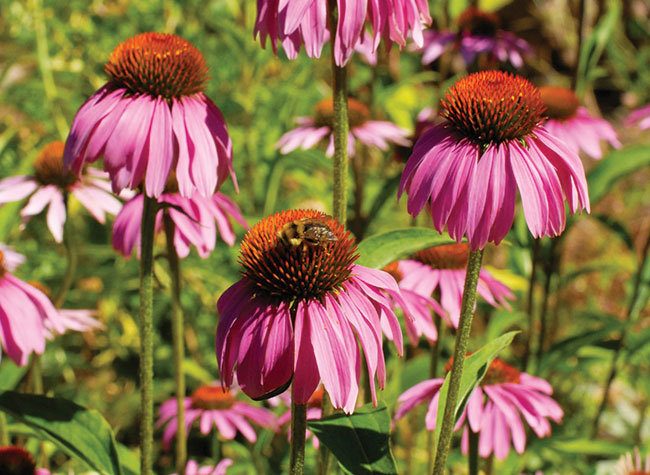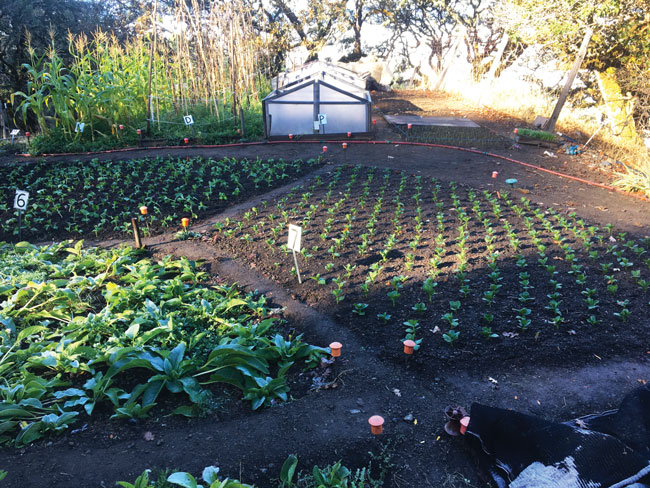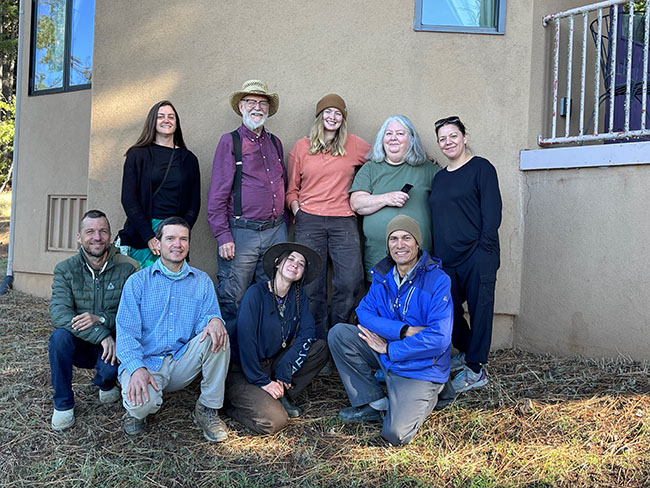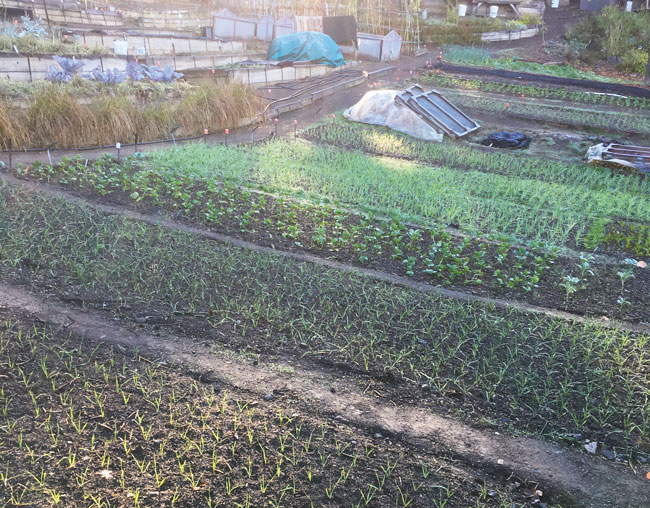The Jeavons Center Mini-Farm Report
Image: Pollinators enjoying Echinacea flowers growing at TJC mini-farm (credit: Cynthia Raiser Jeavons) At The Jeavons Center (TJC, Ecology Action’s GROW BIOINTENSIVE® Closed- Loop Sustainable Mini-Farming world headquarters), we continue to be busy as the minifarm transitions from summer into fall. The optimal planting window for late autumn/winter annual crops at TJC is September 15 - October 15. These crops mature in the early spring and are harvested around May 15 in our climate, and usually include wheat, barley, cereal rye (with its fantastic rooting system: see HTGMV/2017, p.44), Cold-Weather Banner fava beans—fairly rare, which can withstand temperatures up to 110°F (!) and produce a large amount of seed and mature biomass—and garlic. These crops are interplanted with Woolly Pod Vetch
(WPV), selected for its potential to fix almost .63
lb (.29 kg). of nitrogen per 100 sq. ft. (10m2) while
other temperate legumes have the potential to fix less
than .25 lb. (.11 kg) of nitrogen in the same planted
area. This accelerated nitrogen fixation means that
much less WPV seed is needed to fix the .25 lb. of
nitrogen/100 sq ft we need in the soil. The remaining
.25 lb./100 sq ft of nitrogen (for a total of .5 lb./100
sq ft of growing space) is applied in the form of three
5-gallon (20-liter) buckets of cured compost per 100
sq ft (10m2) growing bed. To improve germination
rates, soak the WPV seeds for three days, changing
the water each day. At the beginning of the 4th day,
gently roll the wet seeds on a dry towel to remove
excess water, and then mix them with fine, dry soil
so they will not clump together when broadcast.
This broadcasting should be done after the cured
compost and any organic fertilizers (not manure, it’s
not sustainable) are added and sifted into the soil
4-8 inches (10-20cm) deep. After broadcasting, the
WPV seeds should be gently “chopped” into the soil
5-10 inches (12-25cm) deep. Then you can transplant
annual crop seedlings into the growing bed on offset
centers, and they’ll grow together with the WPV.
When the WPV begins to flower, break the stems off
at ground level, so the nitrogen fixed in the roots will
stay in the soil, rather than being used to produce
seeds. For amounts of nitrogen and carbon required
per 100 sq ft (10m2) growing bed, see the compost
section of Self-Teaching Mini-Series Booklet 14, A
21-Bed Mini-Farm, published by Ecology Action.
For the dynamics of nitrogen-fixation in the soil,
see Managing Cover Crops Profitably, published by SARE.
Image: Fall/winter fava beans planted alongside still-ripening summer crops (credit: David Troxell) TJC’s Farmer Teacher Trainer (FTT) Team includes Mini-Farm Manager Melvin Castillo, Assistant Mini-Farm Manager Suraya David Sadira, and FTT Jessi Mickow. In October, potential FTT Evandro Rachadel started his trial period with us. Welcome tEvandro! As part of our larger International 10-Bed Unit Project, Suraya and Jessi have each designed and planted an experimental 10-Bed Unit (10BU) to investigate the potential of growing a complete balanced diet for one person annually, plus sufficient compost material to feed the soil the diet crops are growing in! They also each have four additional growing beds for doing crop tests of their choice and design.
Image: The Jeavons Center Team, 2023 (credit: David Troxell) Suraya writes: “This year our planned fall-winter
10-BU design included 3 beds of barley, 3 of wheat,
3 of fava beans, and one of cereal rye. However, in
the actual planting, each section always changes a
little as we adjust for time and resources. So far in
the Lower Uphill section of the TJC mini-farm, we
have planted 2 beds of wheat, 3 beds of barley, 2
beds of fava beans, 1 bed of cereal rye, 1 bed of garlic,
and 2 beds of a winter cover crop mix that will
be harvested for immature biomass. In the Middle
Knoll Garden section, we have 3 beds of barley
planted, 2 beds of fava beans, and are working on
getting the other crops in. We have just harvested
4 beds of summer sunflower heads and will be harvesting
the stalks for biomass soon. Summer crops
still growing in the garden include corn, sweet potatoes,
and Jerusalem artichokes that are finishing up, as well as tomatoes and peppers that are still
producing. We are looking forward to phasing fully
into the coming fall/winter season but are still definitely
appreciating where we are at now.”
Image: Winter grains and favas interplanted with WPV (credit: David Troxell) The 2023 Online 8-Month GROW BIOINTENSIVE Internship taught by John Jeavons and Matt Drewno, began the year with 25 participants from four continents on April 4, and will be concluding on November 14 with participants’ Final Presentations during the last two Tuesdays. The five most accomplished participants will be selected to receive an annual award that includes monthly funds and support for two soil tests and amendment recommendations. We always look forward to the GB teaching and demonstration projects that result from these awards, as they are usually exciting and always interesting! Our annual Fall 4-Saturdays Introductory GROW BIOINTENSIVE Workshop began on October 28, and continues through November 18, taught by John and Matt, with seven participants from California, Nevada, Vermont, Oregon, New Jersey, and Kenya. It’s always a pleasure to meet enthusiastic gardeners from such a variety of places! Registration is now open for our Spring 4-Saturdays Workshop (see below). I hope to see your smiling faces there. Looking ahead, John Jeavons has been working with Ecology Action Soil Advisor John Beeby on The Sustainability Fund's Sustainable Soil Fertility International (SSFI) Proposal. This initiative is intended to address the fact that there is as little as 20 years of farmable soil remaining on the Earth. SSFI’s goal is to breathe life and health into agricultural soils on five continents using GROW BIOINTENSIVE, with the assistance of a team of managers trained in John Beeby’s 5-Year Soil Test Analysis and Recommendation (STAAR)/Soil Test Station (STS) Programs (funded by Ecology Action). SSFI’s planned $35,700,000 budget is only ~$0.0045/person given a population of 8 billion people. As human social stability and ecosystem health rely on our ability to grow food successfully and sustainably, fertile agricultural soil is important for a sustainable future. This proposed initiative provides an inexpensive way to help accomplish a globally important goal. A reflection: The best way to greatly reduce the incidence of disease and insects in your crops is to grow a healthy soil. A healthy plant has an amino acid mix in its leaves that is not attractive to insects; plants that are grown in deficient soil can’t produce the right amino acids in the right amounts to repel insects or ward off disease. So if you spot disease or insects infesting your plants, the first thing to do is ask yourself: How am I going to create a healthy soil? …and then accomplish it! Grow Hope Grow Abundance Grow Biointensive! ♥ top | Newsletter Home |Table of Contents| Archive
|







